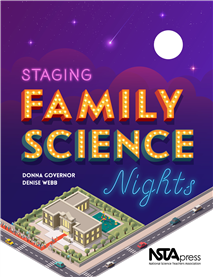Be the Successful Wiz Behind the Curtain to Your School’s Family Science Night
By Carole Hayward
Posted on 2019-04-04
 We have the ancient Greeks to thank for so much of what we continue to enjoy today. Take, for example, the concept of the community theater. Intergenerational groups would gather, all those years ago, in informal settings to both watch and participate in dramas that explored a range of thought-provoking topics. Families would discuss what they’d seen, ask questions, learn together, and communicate big ideas.
We have the ancient Greeks to thank for so much of what we continue to enjoy today. Take, for example, the concept of the community theater. Intergenerational groups would gather, all those years ago, in informal settings to both watch and participate in dramas that explored a range of thought-provoking topics. Families would discuss what they’d seen, ask questions, learn together, and communicate big ideas.
The community theater model is a great analogy for what authors Donna Governor and Denise Webb are trying to achieve in their new book, Staging Family Science Nights, says NSTA Past President Juliana Texley in the book’s forward.
Texley readily acknowledges that planning a Family Science Night will require educators’ time, talent, and even some funding. But she adds that “data document both higher in-school achievement for students who participate with their families and higher support for STEM in communities overall.”
Governor and Webb say that Family Science Nights were the highlight of their teaching careers. They formed a partnership organizing these events while working at adjacent schools and hosted events for thousands of families with students across all levels of K-12 education.
“We want to make it clear… this book is for… elementary teachers, secondary teachers, and teachers of preservice teachers,” the authors explain in the book’s preface. “We found out that Family Science Night events are great for our youngest students, but important for older students as well. We’ve seen older students develop a sense of self-efficacy in science in ways that never would have happened in the classroom.”
This book is a pragmatic planning document that contains two main sections: Section 1 (“Producing the Event”) walks educators through a detailed account of how to make the case for Family Science Night; write the script; cast the event; build the set, procure costumes and props; invite the community; and handle all the last-minute details, challenges, or obstacles that might arise.
Section 2 (“On the Stage”) provides educators with specific suggestions for novice-, intermediate- and advanced-level activities. From balancing a “bug” on your finger, to engineering a roller coaster with loops and turns, to building a hovercraft from a used CD, this book offers nearly 40 different activities to engage learners of every age.
Governor and Webb even created an appendix where they share a variety of forms, letters, and information that they used over the years in producing their own Family Science Nights. It’s hard to imagine a detail that these two overlooked.
Having two experienced mentors who have created a such an extensive, creative, and practical A to Z list of everything you need to host Family Science Night is sure to support your success.
Read a sample chapter. Then learn how to order your own copy. The show must go on!
Follow NSTA
Disclaimer: The views expressed in this blog post are those of the author(s) and do not necessarily reflect the official position of the National Science Teaching Association (NSTA).


